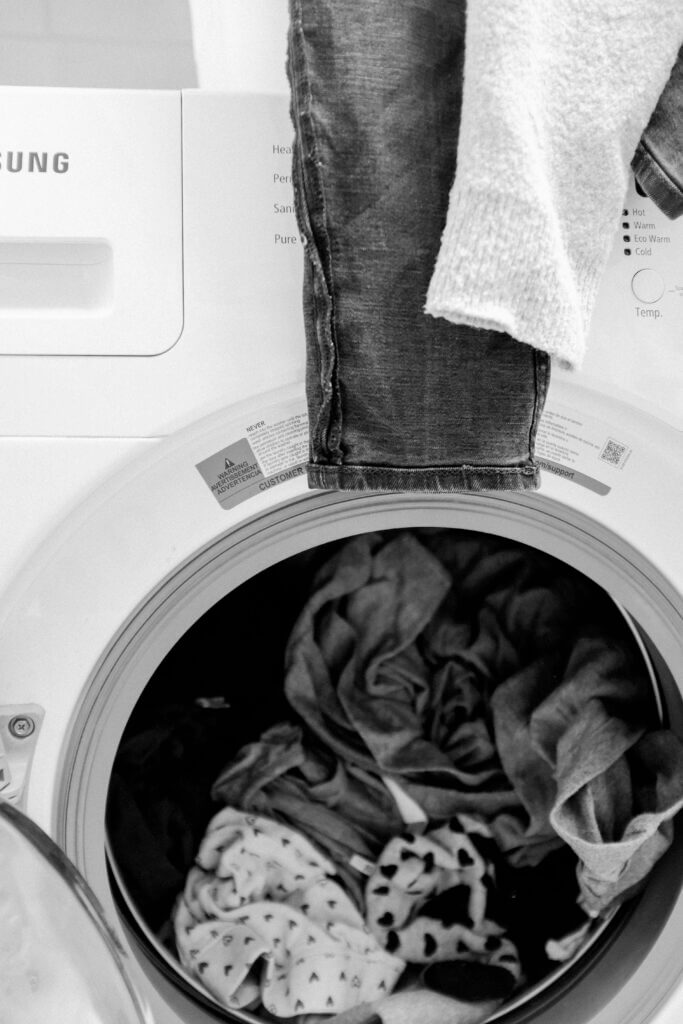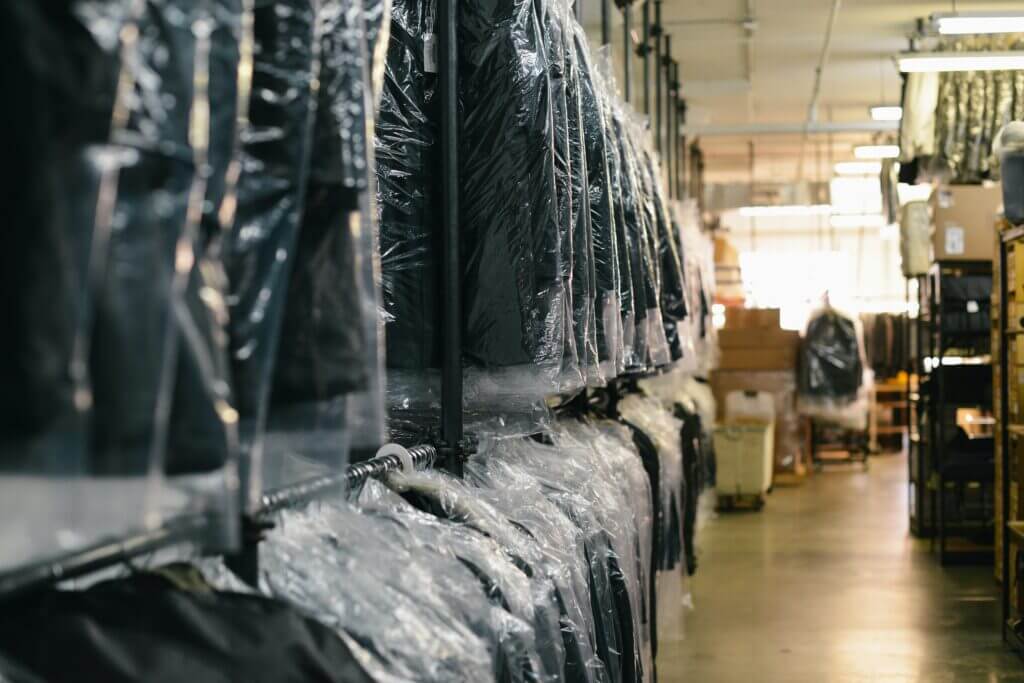Viscose, a synthetic material that resembles silk, has gained popularity for its luxurious feel against the skin. However, handling this delicate fabric carefully is crucial, especially during laundry. Despite its initial appeal, Viscose is prone to shrinkage due to its fibre properties, which can cause disastrous laundry experiences. If you own viscose clothing, there is a high chance it will shrink.
Luckily, there are ways to avoid this issue and correct it if it happens. Prevent viscose shrinkage and enjoy longer-lasting clothes by taking extra precautions and following proper washing instructions.

Why is Viscose so prone to shrinking?
Viscose, although luxurious, is an extremely delicate material that isn’t suitable for everyday wear or easy handling. Its lack of elasticity and high absorbency makes it prone to damage when wet or in the washing machine. Blending viscose with cotton can reduce shrinkage risk, but 100% viscose clothes are highly susceptible to up to 25% shrinkage, rendering them unusable.
Working with this material requires extra care, and following proper washing instructions is crucial to avoid shrinkage and damage. Preserve the beauty and quality of Viscose clothing or items by taking necessary precautions.
Does It Shrink a Lot?
Viscose shrinkage varies depending on how it’s handled and cared for. A 3% shrink may seem small, but it can still noticeably affect the fit of the garment. If not handled correctly, Viscose is prone to significant shrinkage.
Minimize or prevent shrinkage by taking necessary precautions such as carefully controlling temperature and following proper washing instructions. It’s best to prepare for the worst and handle the fabric with extra care to preserve its beauty and quality.
What’s the Extent of Shrinkage in Viscose?
Providing absolute shrinkage numbers for Viscose is challenging due to varying factors affecting its response to washing, despite estimated percentages being available. Improper handling may result in a 3 to 5% shrinkage rate for Viscose, but some sources report up to 25% loss in the first wash.
External factors such as temperature and other conditions may contribute to the extent of the shrinkage. Therefore, it’s best to prepare for the worst and handle Viscose with extra care to avoid any shrinkage issues. Preserve the quality and beauty of your viscose garments by taking necessary precautions and following proper washing instructions.
Does Viscose Shrink In The Dryer?

High heat in a dryer is likely to cause shrinkage in viscose clothing. As such, labels on most viscose products and blends typically advise against tumble-drying after washing. Hang your garments to air dry in the sunshine to preserve their integrity.
Follow the washing instructions carefully and carefully handle viscose to prevent shrinkage.
Does Viscose Shrink When Washed?

Careful handling is necessary during washing to prevent damage to items containing these fibres. The combination of water temperature and agitation in the machine can harm the fabric’s integrity. Following the manufacturers’ instructions for washing and drying is crucial to ensure the longevity and quality of your viscose clothes.
Does Viscose Shrink With Every Wash?
Viscose is prone to shrinking with each wash cycle, and exposure to water can weaken its fibres, leading to future shrinkage. You should avoid using a dryer on Viscose to minimize shrinkage. Regular washing of viscose clothing in a standard cycle may cause it to shrink with each wash.
Does Viscose Shrink In Cold Water?
The good news is that Viscose is less likely to shrink when washed in cold water. Choosing a cool hand wash setting in your washing machine or hand washing your viscose garments can prevent shrinking issues. Using the lowest temperature possible on your washing machine is best to minimize the risk of shrinkage.
Hand washing also allows you to control the water temperature more accurately.
Does Viscose Shrink in Hot Water?
It’s crucial to be mindful of the water temperature when cleaning viscose clothing. Most care instructions advise avoiding hot water as it could cause shrinkage and damage to the fibres. Rapid temperature changes could also lead to significant contraction and changes in size. Opting for a cool or cold water wash is best to avoid any potential issues.
Does Viscose Shrink When Dry Cleaned?

That’s correct. Dry cleaning is a safe option for cleaning viscose clothing and is unlikely to cause any shrinkage. However, it can be expensive and may not be feasible for all garments. Check the care label on your viscose clothing before cleaning it; some garments require specific instructions.
Shrinkage of 95% Viscose: What to Expect
Blends with other fibres are generally more stable and less likely to shrink compared to 100% viscose items. The other fibres can add stability and help prevent shrinkage. However, it’s still important to be careful with the temperature and follow the care instructions on the label. As you mentioned, lower percentages of Viscose in the blend can also increase the chances of success when machine washing.
Can Viscose Shrink More Than Once?
Unlike fabrics such as cotton, pre-shrinking viscose clothing is ineffective because the fibres in Viscose react differently to heat and water. The shrink-resistant coating on certain viscose garments may help prevent or reduce shrinking in the initial washes. However, it will eventually wear off, and subsequent washes can cause the garment to shrink. Therefore, it’s essential to follow the care instructions on the label of your viscose garment to prevent or minimize shrinkage.
How To Wash Viscose Without Shrinking
Your viscose clothing should be dry-cleaned to prevent shrinkage. Save money on dry cleaning and opt for a home dry-cleaning kit or handwash your viscose garments instead.
Use a lingerie or dry cleaning bag for viscose garments in the home dry-cleaning kit and add the dry-cleaning sheets. Tumble the clothes in the dryer on a no-heat setting according to the package instructions. Afterwards, if the clothes are still damp, lay them flat to dry or hang them on a clothesline.
For those who favor hand washing, address any stains on your garments first. Next, gently agitate the clothes in a basin filled with cool water and a gentle soap. Allow them to soak for around 15 to 20 minutes before emptying the sink. Refill it with cool water and agitate the garments once more until no more suds appear. This process might require multiple drain and refill cycles.
When the water no longer bubbles, drain the sink and gently squeeze the water out of the clothes. Lay them flat to dry, reshaping them as necessary. Alternatively, hang them on a rack or clothesline once they dry. Avoid hanging wet viscose clothing as the weight may weaken the fibres. Note that viscose clothing can shrink when washed, especially with hot water or heavy machine cycles.
Also, follow the care instructions on the garment label and avoid exposing Viscose to high heat, agitation, or bleach.
Can you reverse viscose shrinking?
Fix a shrunk garment by soaking it in cold water and conditioner to stretch it back out. No guarantees, but it’s worth a try. This technique has been successful with other fabrics, so it may work with viscose as well. After soaking, stretch the fibres while they are wet and leave the garment to dry.
However, if the shrinkage is severe, it may be impossible to restore the garment to its original size and shape.
(For general concerns about “is viscose stretchy”, head there)
Is viscose worth it?

Viscose clothing can be quite delicate and prone to shrinking. It’s important to be aware of the risks involved in handling these garments, such as damage from wet weather or shrinking in the sun.
If you’re not confident in caring for 100% viscose clothing, it may be better to look for blends that are more suitable for your needs. By doing so, you can avoid the worry and frustration of dealing with a garment that may shrink unexpectedly.


